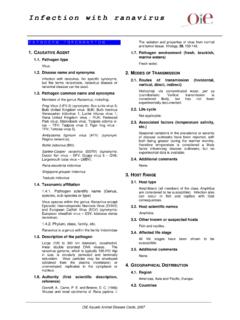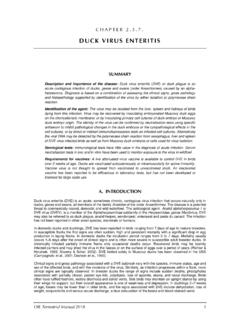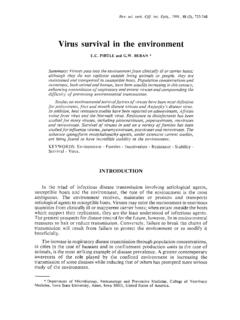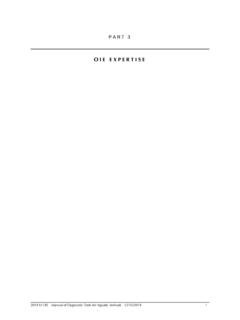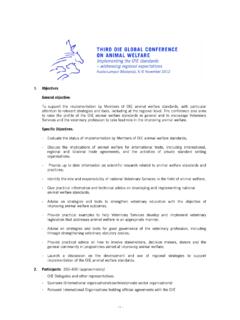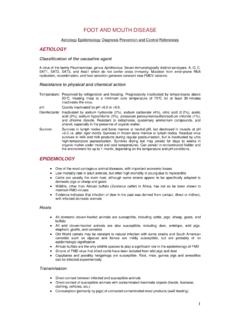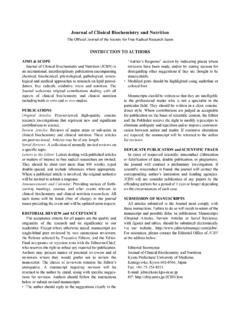Transcription of Veterinary Education Core Curriculum - Home: OIE
1 September 2013 Veterinary Education core Curriculum OIE Guidelines The OIE acknowledges the important contribution of the ad hoc Group on Veterinary Education , comprising:Chair: Dr Ron DeHaven (American Veterinary Medical Association) Dr Saeb Nazmi El-Sukhon ( Veterinary academician, Jordan)Prof. Pierre Lekeux ( Veterinary academician, Belgium)Prof. Louis Joseph Pangui ( Veterinary Dean, Senegal)Prof. Aaron S. Mweene ( Veterinary Dean, Zambia)Dr Froil n Enrique Peralta ( Veterinary Dean, Paraguay)Prof. Timothy Ogilvie ( Veterinary Dean, Canada)Dr Dao Bui Tran Anh ( Veterinary academician, Vietnam)Dr Brian G. Bedard (The World Bank)Dr Etienne Bonbon (European Commission)Dr Tjeerd Jorna (Past President, World Veterinary Association) WORLD ORGANISATION FOR ANIMAL HEALTH, 2013(OIE [Offi ce International des pizooties])12, rue de Prony, 75017 Paris, FRANCET elephone: 33-(0)1 44 15 18 88 Fax: 33-(0)1 42 67 09 87E-mail: The OIE developed these Guidelines for a Model core Veterinary Curriculum to serve as a companion to its recommendations regarding the competencies of graduating veterinarians ( Day 1 graduates ) to assure the quality of the public and private components of National Veterinary Services ( Day 1 Competencies ).
2 The Day 1 Competencies were published in May 2012 ( ). It is proposed that the following Guidelines serve as a tool for Veterinary Education Establishments (VEE) in OIE Member Countries to use when developing curricula to educate Veterinary students to the expected level of competency. As stated in the Day 1 Competencies document, veterinarians in every nation are responsible for the delivery of Veterinary Services of public interest that is, services provided under the legislative framework and the auspices of the governmental authority of a given country to implement animal health to assure the health and wellbeing of animals, people and ecosystems. Because the OIE defi nition of Veterinary Services covers both government and private sector veterinarians, these OIE Guidelines on Veterinary Education core Curriculum apply equally to those working in the private and public sectors.
3 It must be noted, however, that the OIE is not recommending the adoption of a single global Curriculum . Indeed, the OIE recognises the autonomy of universities and Veterinary faculties in its Member Countries, particularly with regard to development and delivery of the Curriculum . Further, given the vast societal, economic, and political differences among OIE Member Countries, the Model core Veterinary Curriculum Guidelines described here are primarily offered for those developing and in-transition countries seeking tools that can be used to improve the quality of Veterinary medical Education as an initial step in enhancing the delivery of National Veterinary Services and public and private support for Veterinary Education Establishments. The guidelines represent a basis on which national needs and circumstances could be added. The OIE indeed recognises that these Guidelines refer to one model core Curriculum .
4 In addition, this model is intended to accommodate a variety of Veterinary educational systems that occur over a four-, fi ve- or six-year Curriculum . For example in the USA, students typically complete at least two years of undergraduate university Education to fulfi l minimum educational prerequisites prior to being admitted to a Veterinary Education Establishment with a four-year Curriculum leading to the professional degree of DVM (or VMD). In many other countries, Veterinary schools accept students directly following successful completion of secondary (high) school, and the Veterinary Education Establishment Curriculum is fi ve or six years leading to a variety of degrees (BVM, BVSc, MV, MVS, MVSc). Furthermore in some countries, secondary school curricula may include courses more commonly taught in undergraduate university-level curricula in other countries. As such, the recommended sequencing of the courses in this Model core Veterinary Curriculum must be adjusted to refl ect the length of the Veterinary degree programme and the pre- Veterinary course requirements.
5 Model core Veterinary Curriculum The Model core Veterinary Curriculum is presented in the following table. It includes a brief description of each recommended course (or course content). Each course is then linked (or mapped ) to one or more of the previously described Day 1 Competencies addressed by that course. Some competencies ( , Research, an advanced competency) are not specifi cally mapped, because they are inherently addressed by the vast majority of recommended courses. Likewise, although Communication Skills, a specifi c competency, is only mapped to the communication course/course content listed in the following table, this skill is also addressed by all other courses/course content. 4 The Model core Veterinary Curriculum also offers sequencing recommendations for each course; that is, whether the course content should be offered early, midway, or late in the Curriculum .
6 The recommended sequencing will need to be adjusted when developing a specifi c Curriculum for a given Veterinary Education Establishment in an OIE Member Country in order to refl ect the length of the Veterinary degree programme and the pre- Veterinary course requirements in that country. For example, courses to address general competencies, including basic Veterinary sciences and animal production, may be integrated in their entirety early within the Veterinary Curriculum or as pre- Veterinary educational requirements for admission into a Veterinary Education recommended course content described in the table may be offered as discrete, individual courses or, alternatively, course content may be combined and integrated over multiple courses, depending, in part, on the teaching modalities used by each Veterinary Education Establishment ( , didactic learning, laboratory or hands-on learning, small-group learning, problem-based learning, self-directed learning).
7 Each Veterinary Education Establishment will also need to consider the anticipated level of competency desired of the Day 1 graduate for basic vs advanced competencies ( , mastery vs general awareness and appreciation of) when determining the duration and depth of each course to include in its Curriculum . The following assumptions have been made and defi nitions used in developing this Model core Veterinary Curriculum : The Model core Veterinary Curriculum assumes that each student enters Veterinary school with a solid understanding of the basic sciences ( , chemistry and physics) as well as the Arts and Humanities as required by the parent university for initial admission into the programme. As such, these courses are not addressed at all in this model. The Model core Veterinary Curriculum assumes that there is less need for the OIE to make specifi c recommendations on the competencies of the Day 1 graduate in medicine, surgery, diagnostic imaging, theriogenology, and anesthesiology than in matters relating directly to the OIE mandate.
8 As such, the model groups these disciplines together and describes them under course content as clinical and diagnostic skills. It is understood, though, that in some Member Countries, licensure or registration to practice through a Veterinary Statutory Body (VSB) will require a higher level of competency in these disciplines. Veterinary Education Establishments in these countries will, therefore, need to place a greater emphasis on instruction in these clinical skills. The terms animals, groups of animals and species of interest include all those animals of Veterinary interest in a specifi c country or region, such as: animals domesticated for food production (herds, fl ocks and other groupings), non-domesticated animals (captive and free-ranging terrestrial, avian, aquatic and marine wildlife), companion animals, and service and sporting , it must be emphasised that given the vast societal, economic, and political differences among OIE Member Countries in relation to educational needs, each Veterinary Education Establishment may need to complement this Model core Veterinary Curriculum accordingly to meet its specifi c local or national educational needs.
9 However, it must be emphasised that such country or VEE-specifi c modifi cations need to retain the original intent of the model that is, to educate Veterinary students to achieve the OIE recommendations on the Competencies of graduating veterinarians ( Day 1 graduates ) ( Day 1 Competencies ). 5 Model core Veterinary CurriculumCourse or course contentSequence in VEE CurriculumDay 1 Competencies addressedDescriptionGeneralSpecifi cAdvancedBiochemistryEarly biochemistry provides the linkage between the inanimate world of chemistry and the living world of biology. Course content should provide the Veterinary student with a broad understanding of the structure and function of essential biological molecules ( , proteins, lipids, carbohydrates, DNA, RNA) and metabolic and regulatory pathways. Comparative features among animal species of particular relevance to the Member Country should be highlighted.
10 Genetics Early Genetics is the branch of biology that deals with heredity, especially the mechanisms of hereditary transmission and variation of inherited characteristics among similar or related organisms. Course content should provide the Veterinary student with a broad understanding and use of basic concepts of general and molecular genetics ( , molecular constitution of genes and chromosomes, manner in which genes move through generations in a population, genetic abnormalities, genetic testing). Focus should be on animal species of particular relevance to the Member Country. AnatomyEarly Anatomy is the study of the structures of domestic animals, and includes relevant histology (study of the microscopic anatomy of cells and tissues) and embryology (study of embryos and their development). Course content should provide the Veterinary student with a broad understanding of the development, structure and function, both at the gross and microscopic level, of the major systems ( , musculoskeletal, nervous, cardiovascular, immune) in animal species of particular relevance to the Member Country.

